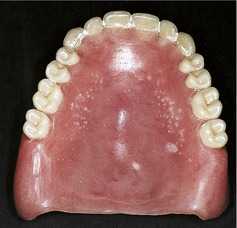Case• 12. A defective denture base
SUMMARY
The acrylic denture base and cobalt–chromium casting shown both have defects caused by similar mechanisms. Can you identify the problem and its causes, which are different in the two examples.
Acrylic complete denture
▪ A heat-processed ‘acrylic’, poly(methylmethacrylate) denture base is shown inFigure 12.1. What do you see and how do you interpret these observations?
The denture base has a cluster of small round holes in a horseshoe-shaped distribution just inside the teeth. The defects are more frequent in areas of thicker acrylic. Each defect appears to be round, some are completely enclosed in acrylic, while others communicate with the surface via sharply defined holes.
The presence of numerous small holes or defects within the acrylic is known as porosity.
▪ What are the types of porosity? How do they manifest and what are their causes?
The types of porosity are presented in Table 12.1.
| Defect | Manifestation | Cause |
|---|---|---|
| Contraction porosity | Porosity throughout the denture. The denture may be the incorrect shape. | Insufficient material packed into the flask, or inadequate flasking pressure. Correct use of the trial packing stage should eliminate this. |
| Gaseous porosity | Porosity in a localized area of the denture base, particularly in the thicker parts. Each defect is round and sharply defined. | Vaporization of monomer during processing. |
| Granular porosity | Porosity appears in thin sections of the denture, which often have a ‘white and frosty’ appearance. | Incorrect polymer: monomer ratio when producing the dough, or failing to pack the flask at the dough stage. |
This denture has suffered from gaseous porosity and the appearances are typical but more extensive than usually seen.
Stay updated, free dental videos. Join our Telegram channel

VIDEdental - Online dental courses



